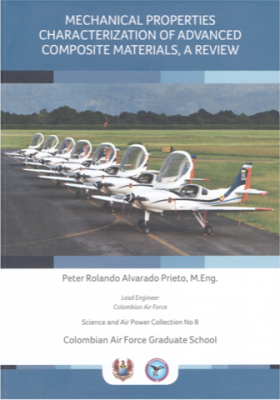Visitas
Mechanical properties. Characterization of advanced composite materials
Sinopsis
This book is intended to improve the technical understanding and practical knowledge about composite materials characterization of practicing engineers, researchers and students. Particulary for the Colombian Air Force, it will be used as a guide during the T-90 aircraft certification program where the autor is participating. May it also contribute for new materials development and its use in future aircraft designs in Colombia.
The content is a compilation of lessons learnt and knowledge acquired during research and work done at Purdue University and as a lead engineer in the Colombian Air Force, on advanced composites materials and characteriztion. Each topic addressed in the development of this document, will allow the reader to understand the basic concept of this matter, and to identify the tools, analysis and equations needed to fabricate and characterize advanced composite materials.
As a whole was designed to assist the development of the Colombian Aerospace Industry as a guide during the experimental characterization of the composites materials used in the Calima T-90 aircraft and to be a reference for future aircraft development projects led by the Colombian Air Force. However, its application can extend beyond the aerospace field, since composite materials are also used in other areas such as sportive equipment, automobiles, construction, and ballistic protection, among others.
Chapter 1 introduces the topic of advanced composites which defines the basic concept required to understand the main topic of the book. It shows how to fabricate a composite laminate by the hand lay-up method using prepreg and autoclave curing. At the end of this chapter it is expected that the reader, with the necessary tools, materials and equipment, can be able to fabricate a flat composite laminate. In Chapter 2 it is shown how to obtain properties of Lamina Tensile from a tension test. It is an introduction to the testing procedure using tensile testing machine, strain gages and date acquisition systems. Chapter 3 explains how the in plane shear properties of composites can be obtained by testing a +-45 specimen in tension. In chapter 4, besides of explaining how to perform test in off axis specimens, introduces the reader to failure prediction approaches in composite materials. Chapter 5 tells about the material Flexural Test. Chapter 6 introduces a design feature behavior of composite materials regarding holes. It shows how the strenght changes depending on the hole sizes, and also introduces failure prediction criteria. Chapter 7 and 8 are about the Lamina and Laminate Coefficient of Thermal Expasion respectively, and finally, Chapter 9 is about the Mode I Fracture testing, to see how a crack propagates through a lamina.
Descargas





